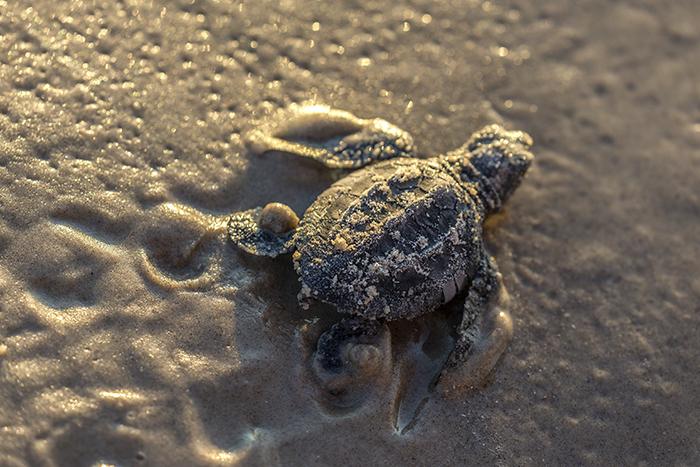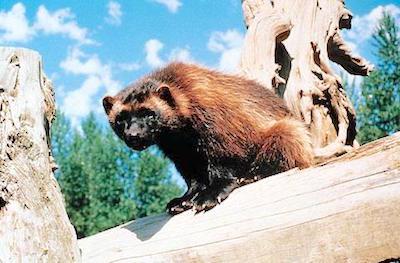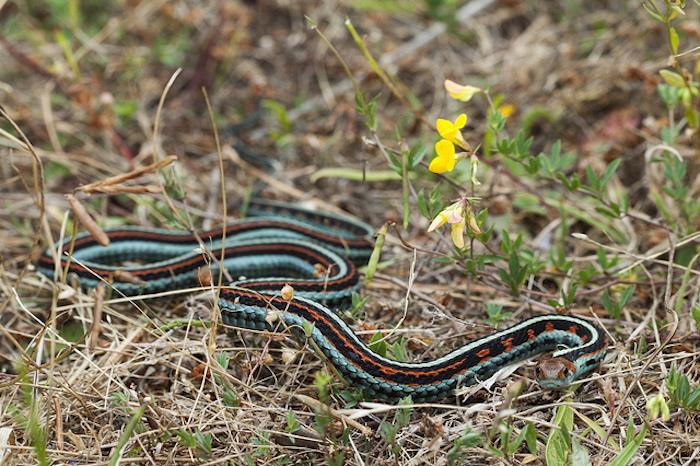
Parks such as Padre Island National Seashore, home to an acclaimed recovery program for Kemp's ridley turtles, could become islands in the protection of threatened and endangered species under proposed changes to the Endangered Species Act/Rebecca Latson
Waves of hatchlings scurry towards the surf, orienting themselves to the rising sun and plunging into the water, natural born swimmers. These Kemp's ridley turtle youngsters are a linchpin for the survival of the most endangered sea turtle in the world. Over the course of a summer, thousands of these armored turtles splash into the Gulf of Mexico.
Were it not for Dr. Donna Shaver and her sea turtle program at Padre Island National Seashore, a 70-mile sliver of barrier island in Texas along the Gulf of Mexico, the species' future might not have any glimmer of hope.
"Padre Island sort of modeled the right behavior to save them, which was protecting the eggs and the hatchlings. And that inspired others to do the same thing outside the Padre Island seashore," said David Graber, whose last role in his nearly 40-year career with the National Park Service was as chief scientist for the Pacific West Region.
That was one tidbit of endangered and threatened species knowledge Graber shared as we discussed the rule changes the Trump administration wants to make to the Endangered Species Act, a 45-year-old cornerstone of protectionism bestowed on plants and animals, insects and shellfish, birds and fish. Signed into law in 1973 by President Richard Nixon, the measure was overwhelmingly endorsed by Congress, passing the House on a 390-12 vote and the Senate by 92-0.
While Graber and others don't deny the ESA could use some updating, what the administration is looking to enact is raising fears that it will turn many portions of the act on their head.
* Economic factors could be considered when the status of a species is reviewed for ESA protection.
* Species given a "threatened" designation would not necessarily enjoy the same protections as those considered "endangered."
* Changes could preclude existing requirements as to which federal agencies are consulted on a prospective listing.
* How critical habitat designations are made could ignore a species' historic habitat that is currently unoccupied by that species.
Interior Secretary Ryan Zinke's drive to open as much public land as possible to energy exploration has more than a few onlookers seeing these rule changes as designed to keep the ESA from leading to "critical habitat" designations that could take some lands out of play for development. What happens outside parks, in terms of habitat for endangered and threatened species, is incredibly important for those species inside parks.
"What we would say is that for sea turtles, the more habitat for them the better. Animals often do not recognize geographic boundaries that we humans designate," said Dr. Shaver.
Graber, no doubt like many, was trying last week to fully understand what exactly the administration and some members of the House of Representatives who had introduced a package of measures aimed at changing the ESA were trying to accomplish.

David Graber, who retired from the National Park Service as chief scientist for the Pacific West Region, worries how rule-making changes to the Endangered Species Act will impact species in need of protection.
"If I understand what I’m hearing in the news, the Republicans don’t think that they can repeal the Endangered Species Act, (but) they think they can weaken it. And it depends on what it is they do with it," Graber replied when I asked him what threats those proposed changes would have to species on the ground inside the National Park System.
At first blush, one might think species in the parks are protected by their very location. But, as Brian Rutledge, a National Audubon Society vice president overseeing the organization's Sagebrush Ecosystem Initiative, pointed out, many species go beyond park borders.
"I’m very concerned about the idea that we no longer automatically protect threatened species. Which of course keeps them at risk longer, and makes them more likely to be declared endangered," Rutledge said during a call from his Colorado office. "Certainly, inside the parks, we’re theoretically protecting all the species that they can support. But, none of those species necessarily recognize those boundaries. And so, the expanse of lands that adjoin most of our great parks is certainly a big part of the life cycle for those species that use the parks."
Bison, elk, pronghorn antelope, and grizzly bears are all good examples of that point. They come and go -- some depending on the season, others on a whim -- and the protection offered by the National Park Service Organic Act that charges the Park Service with preserving that wildlife doesn't shadow their movements.
"We’ve had this huge discussion around sagebrush the last many years, because literally all the big game that you see in Yellowstone, for example, in summertime spends its winters in the sagebrush," Rutledge pointed out. "If we eliminate those protections, you move everybody closer to trouble.”
At the Center for Biological Diversity, a nonprofit that works "to secure a future for all species, great and small, hovering on the brink of extinction," Government Affairs Director Brett Hartl agreed with Rutledge.
“If a species needs more room to roam beyond the park, this type of proposal basically rejects that entire approach towards conservation," he said. "It basically says unoccupied habitats are not important. It says critical habitat is not important, it weakens protections for threatened speices. So, the parks will still be those great refugia, but that’s going to be it. If you care about long-term, viable populations of wildlife that are really functioning like you hope they would in the ecosystem, then that’s not going to happen anymore."
And if the administration's delisting of grizzly bears in the Greater Yellowstone Ecosystem withstands legal challenges, and the population falls in the years to come where the bruins might again need ESA protection, that might be harder to provide, said Hartl.
"If they lose protections it will be harder to get them back in the long run," he said. "That is one of many, many reasons these rules are bad. They’re terrible all across the board. … Like if we delist grizzly bears, and we had to relist them later, the same thing for wolves. It’s just going to be harder to even get them on the list. None of this is positive.”
Costs Of Working To Save Species
Source: U.S. Fish and Wildlife Service Federal and State Endangered and Threatened Species Expenditures
Total Expenditures for FY2016 = $1.4 billion (Land acquisitions not included)
Expenditures on mammalian species = $199 million
Expenditures on bird species = $145.6 million
Expenditures on reptilian species = $62.7 million
Expenditures on fish species = $800 million
Expenditures on clam species = $14.6 million
Expenditures on insects = $11.7 million
Expenditures on corals = $8.1 million
Expenditures on flowering plants = $38.1 million
Select species expenditures:
Steller Sea lion = $22.1 million
Florida Panther = $3.6 million
West Indian Manatee = $5.4 million
Long-eared Northern Bat = $12.7 million
Indiana Bat = $14 million
Grizzly Bear, Bitterroot Ecosystem Recovery Zone = $11.7 million
Gray Wolf = $6 million ($3.3 million in Minnesota alone)
Ivory-billed woodpecker = $2,347
Red-cockaded woodpecker = $25 million
Piping Plover, Atlantic and Northern Great Plains populations = $11.3 million
Piping Plover, Great Lakes populations - $1.5 million
Northern Spotted Owl = $15.6 million
Kemp's ridley sea turtle = $4.3 million
Leatherback sea turtle = $4.9 million
The steelhead trout population in the Middle Columbia River, a threatened species, during Fiscal 2016 received the most recovery funds out of 1,401 species, with $64.4 million spent on its recovery.

Wolverines, which are not listed as a threatened or endangered species but whose population is counted in the low hundreds, could find it harder to gain ESA protection under the Trump administration's proposed changes.
How many threatened and endangered species live in the National Park System? That's a difficult question, as Park Service staff had to check with Interior Department officials to see if they could release the latest numbers.
However, in 2010 the agency counted 291 endangered species and 121 threatened species in the parks. There also were six experimental species, and three species that were considered "threatened by similarity of appearance."
Plant species with ESA protection in 2010 accounted for 175 of the 421 ESA species in the park system, while bird species represented 55 of the total, mammals 52, and invertebrates 49. Fish species accounted for 48 of the total threatened and endangered species in the parks, while reptiles represented 20, insects 16, amphibians five, and arachnids one.
They include species such as the Florida panther in Big Cypress National Preserve and Everglades National Park, the wolverine in places such as Glacier National Park and North Cascades National Park, the West Indian manatee at Biscayne National Park, the black-footed ferret in Wind Cave and Badlands national parks, the Ozark hellbender at Ozark National Scenic Riverways, the Sierre Nevada yellow-legged frog at Yosemite National Park, and the Geranium arboreum at Haleakala National Park.
Total expenditures for all those species in the parks in 2010 totaled $12.2 million.
Efforts in Congress to tinker with, tweak, or simply throw away the ESA are not new, though in recent history their proponents haven't enjoyed the control the Republican Party has now over Congress and the White House.
U.S. Rep. Raúl M. Grijalva, a Democrat from Arizona who is the ranking member on the House Natural Resources Committee, released a blistering statement when the Trump administration announced its intentions.
“The Trump administration doesn’t seem to know any other way to handle the environment than as an obstacle to industry profits, and House Republicans don’t seem to know any other response than standing around and applauding bad decisions," he said. "If a single company can make a single dollar from the destruction or displacement of an endangered species, it’s full speed ahead. The public doesn’t demand this; this is part of the endless special favors the White House and Department of the Interior are willing to do for their industry friends. It’s reprehensible and it needs to be opposed and reversed.”
From Graber's viewpoint, he just wishes politicians wouldn't play games with the Act but be honest about a species' plight.
“My little strange obsession is that whatever you do with the Enangered Species Act, don’t pretend that an animal isn’t endangered if it is," said Graber, a member of the Coalition to Protect America's National Parks executive committee. "Be honest and say, 'Yes, the scientists tell us this animal is heading towards extinction. And no, we’re not going to spend a nickel to save it, but at least we’re going to admit that we’re going to lose it.'
"And as it happens," he continued, "the vast bulk of listed species have not gone extinct, but they’ve also not come off the list. They just sort of hang around because, frankly, in many cases, we don’t know what it is we have to do to bring back the populations.”
It was something of a fluke that the Channel Island Fox, once down to what the U.S. Fish and Wildlife Service described as "near-catastrophic levels," now represents what the agency calls "the fastest successful recovery for any ESA-listed mammal in the United States." Endemic to Channel Islands National Park, the foxes' population went spiraling down in the late 1990s as canine distemper swept through the species and non-native Golden eagles found their way to the park and discovered the small predators to be easy prey.
It turns out, Graber explained to me, that the fox never considered a threat from above, and so didn't flee when a shadow swept over them. Once the eagles were removed from the islands, a captive breeding program was tried, but the foxes wouldn't mate in captivity. Once they were released back to the wilds, they went back to repopulating their species, he said. Today the species carries a "threatened" designation, but the Fish and Wildlife Service has proposed to delist them.

The San Francisco Garter Snake/Natalie McNear, flickr
In another case, that of the extremely colorful San Francisco Garter Snake, staff at Golden Gate National Recreation Area caused something of a population boom when the park was given land at Mori Point, said Graber. Park staff wanted to reclaim the land and restore it to its natural appearance, but they weren't exactly sure what that appearance was, he explained. So they recontoured the land, put in two ponds, and added a boardwalk for visitors to enjoy.
“As soon as they dug the ponds, the California red-legged frog, which is a listed species, appeared. Boom," Graber told me. "And then the next year, the San Francisco Garter Snake appeared to eat the red-legged frogs. They’re doing OK, by the way. That’s probably the safest habitat. This tiny, tiny park is probably the safest habitat for the garter snakes.”
Ironically, the scientist pointed out, the snakes, an endangered species, dine on a threatened species.
In another blow to endangered species, Fish and Wildlife Service officials announced Friday that they would withdraw two Obama-era policies that provided "guidance on the appropriate use of mitigation to advance the conservation of wildlife and habitat," The Nature Conservancy said.
“This disappointing decision throws away many years of effort to develop and implement conservation practice that supports species and habitat while providing predictability for the development community,” said Lynn Scarlett, co-chief of external affairs at The Nature Conservancy. “Rescinding these policies outright without a commitment to replace them creates an unstable and unpredictable policy landscape, leaving field staff with insufficient guidance and direction on how to comply with their mandates to protect species and their habitat.
“To succeed in protecting species and providing opportunity for continued economic development, we need well-designed federal mitigation policies to help balance development and conservation. We urge the Department of the Interior to reverse its decision," she said.
While the recent news is bleak for wildlife and plants struggling to survive, James Fraser, a professor at Virginia Tech University, nevertheless remained optimistic that these policies would not stand.
"The public supports endangered species, unless of course they’re in their back yard, then it’s a problem. Or can be," Fraser, a professor in the university's College of Natural Resources and Environment who focuses on population, behavior, and habitat ecology of imperiled species, said during a phone call last week. "This is just not Americans, it’s world-wide. I think people who don’t have enough money to put shoes on their feet care about conservation of species. So I think it’s a worldwide thing, I think there’s always going to be support for it. How long it takes us, if these guys really get these regulations changed, how long it takes us to reverse that in the future is hard to say, but I just don’t see this desire to conserve species disappearing.”



Add comment